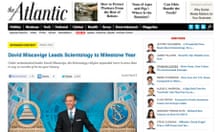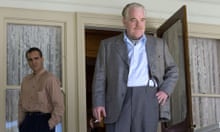Some dairy-devoted Americans smuggle hunks of unpasteurised cheese back into their country after holidays in hedonistic ol' Europe. This American engaged in a similarly contraband importation when I returned to London on Monday from a trip to New York with a particular book in my suitcase. Going Clear: Scientology, Hollywood & the Prison of Belief by Lawrence Wright is one of the most keenly awaited books of the year, but those in the UK will continue to wait in vain for it (or fork out exorbitant shipping fees from US-based online booksellers) as, owing to Britain's stiflingly archaic libel laws, Transworld, the book's British publisher, announced earlier this month that "legal advice" had convinced it not to publish Wright's study of the world's most controversial religion. This is a real shame for anyone in this country who is interested, not just in free speech, but learning more about Scientology.
To the fun stuff first. The gossipy details in the book about the mentality and mendacity of Scientology's founder, L Ron Hubbard, and the increasing weirdness of Hubbard's most high-profile devotee, Tom Cruise, are certainly jaw-dropping. But they will not come as much of a surprise to those who have read Wright's 2011 New Yorker article about Scientology and Vanity Fair's recent damning piece about Cruise. Yet even if such stories aren't wholly new, it still feels pretty mindblowing to have them reported by Wright: nearly every horror story you've heard about the violence and secrecy in the Scientology church, every bit of gossip about Cruise and his fellow Scientologist, John Travolta, are pretty much supported by Wright (if denied by the church) and, despite what the Scientology church has said, Wright – a New Yorker staff writer and Pulitzer prize winner – is about as credible as they come.
It is easy to mock a religion that is based on the teachings of a – as Wright describes him – priapic, violent, bigamist pulp-fiction writer who experienced his formative revelation while under anaesthetic during a dental operation, which is partly why so many people do. Similarly, it is easy to argue that Scientology's beliefs are no whackier than those in other religions, although this argument underestimates the cruelty that is not just covered up by Scientology's leaders (Roman Catholicism, after all, is no slouch in that department) but, according to Wright, condoned by them. But it was also the perfect product of its time and place, and continues to be so.
Scientology is a neat reflection of the worst aspects of American culture with its repulsive veneration of celebrity; its weird attitudes towards women, sex, healthcare and contraception; its promise of equality among its followers but actual crushing inequality (one of the more memorable claims in Wright's book is how Scientology promises its followers access to the celebrity world yet is hierarchical to such an extent that when it was discovered Cruise and his then wife Nicole Kidman had a "fantasy of running through a field of wildflowers together", Scientology followers were instructed to "plant a section of the desert".)
Its history is at least in part the history of US counterculture: when Scientology officially began in 1950 with the publication of Dianetics, it emerged in an America fascinated with tales about outer space and increasingly concerned about psychiatry, which was going through a period of brutal experimentation. (Jon Ronson also describes some of the horrors of the mistakes and abuses conducted in the name of psychiatry in mid-century America in The Psychopath Test.) Yet there was a huge influx of patients in mental health wards at this time, partly, Wright suggests, due to the societal changes wrought by the cold war. This is the dark side to the story of the Greatest Generation, and it's a side that produced Hubbard and opened up a window into Scientology. Hubbard promised cures to these patients in hours that were "superior to any produced by several years of psychoanalysis" (and that remains a very American trait: the promise of near instantaneous effects with minimal effort.)
By the 70s, Scientology was seen in Los Angeles – which is where its highest concentration of followers still live; it's a city that has, perhaps unsurprisingly, produced many niche religions – as an expression of bohemian creativity. But by the 90s, America had a growing fear of cults, exacerbated by the disastrous Waco siege, which simultaneously underlined the danger of totalitarian religions but also the government's ineptitude at handling them. This dual anxiety, Wright suggests, is what helped Scientology regain from the IRS its tax exemption status as a bona fide religion.
Hubbard had always been entranced by Hollywood but it was David Miscavige, the church's current leader, who truly upped the celebrity ante, equating fame with a spiritual value and kowtowing to celebrities accordingly.
Recently, on a trip to LA, a friend and I walked across the street to check out the Scientology Celebrity Centre. An extremely polite woman, who had moved from Japan to work for the centre, walked us through the heavily airbrushed history of Hubbard and Scientology before giving us a personality test which would ascertain whether Scientology would be able to "help us". The questions ranged from the banal ("Do other people interest you?") to the baffling ("Do you chew the end of your pencil?") to the creepy ("Could you agree to strict discipline?") But the most memorable part of the trip for me was the wall of photos of celebrities, as if the centre was one of those old New York delis, plastered with yellowing autographed photos of stars who have popped by for corned beef hash, so surely you want some, too? Scientology may not have many members, but it has an outsize presence due to wealth, fame and fear. It is, in its own dark ways, the inevitable religion to emerge from 20th-century America.











